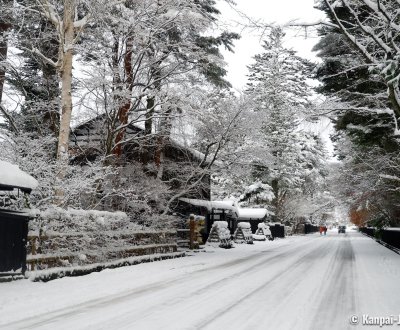Kakunodate
Samurai Houses and Weeping Cherry Trees
Kakunodate is an old feudal town at the center of Akita, in the north of Japan. Located on Semboku City’s territory, the town is renowned for its beautiful historical district of samurai residences called bukeyashiki. From late April to early May, the townscape is further embellished by the blooming of its many weeping cherry trees and somei yoshino sakura.
Kakunodate Castle 🏯 was founded in the Dewa province (straddling today’s Yamagata and Akita prefectures) by daimyo lord Tozawa Moriyasu (1566 – 1590). At the times, the fortress sat at the summit of Mount Furushiro-yama and overlooked a small plain surrounded by mountains and the Hinokinai and Tama rivers.
In 1620, Furushiro-yama Castle was dismantled following the enforcement of a new rule of the Tokugawa shogunate, limiting the number of fortified places to one per province. The neighboring Kubota Castle, now in Akita City, was the one spared for the area’s protection.
Despite losing its castle-town status, Kakunodate nonetheless continued to develop at the foot of the mountain and under the lead of daimyo Yoshihiro Ashina (1575 - 1631). Up to 80 samurai warriors’ families used to live here, gathered in a handful of streets protected by fortified walls.
Kakunodate stayed a large feudal city and has barely changed over the last 4 centuries. Of an easy access by train 🚅, it is one of the major sightseeing destinations in Akita prefecture, appearing as an ideal traditional postcard of Japan, with a preserved architecture enhanced by the blooming of sakura 🌸 in spring.
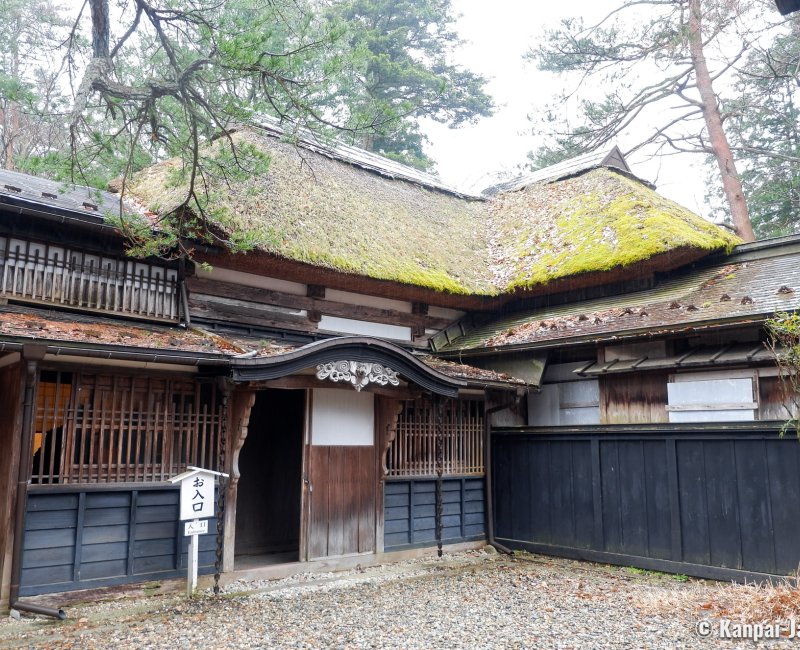
Bukeyashiki district
Located to the north of the city within walking distance from the station, the samurai district (侍町 or さむらいまち samurai-machi) gathers several authentic warrior family houses, called bukeyashiki (武家屋敷 or ぶけやしき) in Japanese. The area retains a quaint charm with dark wooden fences and traditional gates enclosing each property. The family’s hierarchical rank at the times can be guessed just by looking at the estates’ superficies.
Additionally, tall trees, including shidarezakura weeping cherry trees, line the streets and profusely bloom in spring, from late April to early May. These sakura were brought from Kyoto during the Edo period (1603 – 1868) and were the pride of the ancient samurai families, who maintained them as a token of their wealth and prestige. At this time of the year, Kakunodate is visited by about 1 million Japanese tourists.
The main street, logically named Bukeyashiki-dori, serves 5 of the 6 samurai houses opened to the visit. Two of them are particularly remarkable: Aoyagi-ke and Ishiguro-ke.
Aoyagi House (青柳家)
Built on a more than 10.000 m² land, the Aoyagi-ke displays a large garden laid out around a pond, with several independent buildings. The main house is open to the visit, that continues into a family museum sheltering among other things epoch weapons and armors. A souvenir shop, an artisan’s workshop and a restaurant refine the discovery of the place.
Ishiguro House (石黒家)
The residence is the oldest samurai house in Kakunodate, and it is still inhabited by the descendants of the family. It offers a spacious, elegant and traditional inside with tatami flooring and irori central hearth. Ishiguro-ke also displays a beautiful karesansui dry garden including rocks and century-old trees.
Next to the two residences, the Hirafuku Memorial Museum of Art pays tribute to the artworks of local artists Hyakusai and Suisan Hirafuku (father and son). The Kakunodate Kaba-Zaiku Densho-Kan (Kakunodate Cherry Bark Work Museum) exhibits sakura bark craftsmanship.
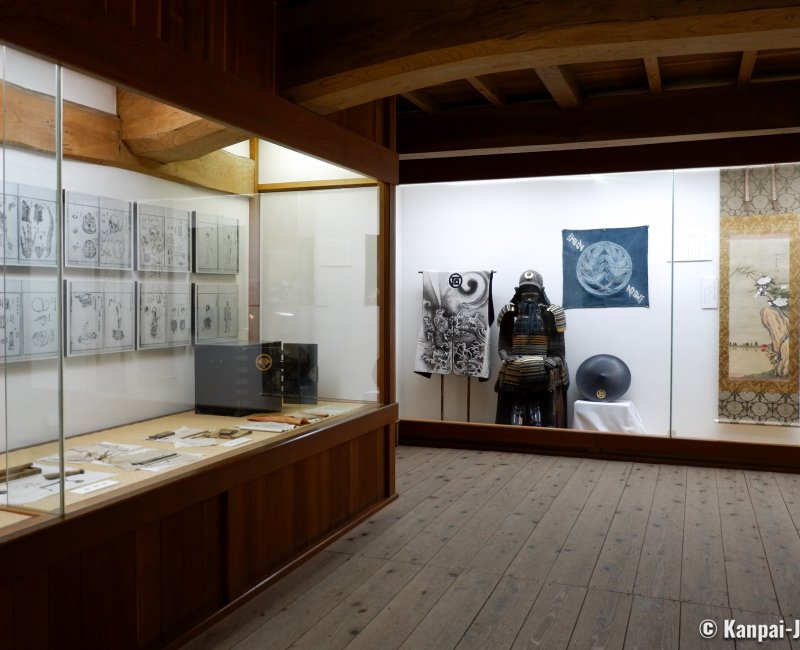
Merchant district
At the south of the bukeyashiki residences, the "outer town" is the historical merchants' district. The buildings’ architecture is more varied and the authentic mingles with the contemporary. If you are looking for the local tradition, you can stop at these 2 addresses:
- Ando Brewery (安藤醸造) founded in 1853 and specialized in the artisanal making of shoyu soy sauce and miso paste. The red bricks construction dates to the Meiji Era (1868 – 1912), and was rebuilt for the last time in 1883. Inside, the decoration is abundant and colorful, especially the mural paintings in the ceremonial room;
- Nishinomiya Samurai House (西宮家) allows a comprehensive tour of its premises, including a tea house, a restaurant and a shop selling items made from kabazaiku cherry bark, Kakunodate’s local craft.
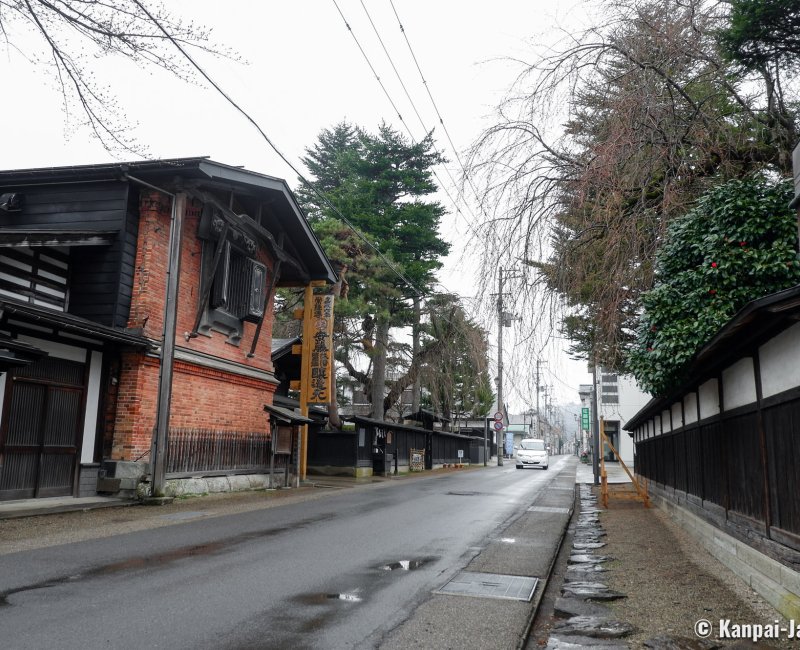
Rivers and mountainous landscapes
Beyond the city center that concentrates most of the cultural visits and services and accommodation necessary to travelers, the close surroundings of Kakunodate offer beautiful excursions, such as:
- The park of Furushiroyama Castle Ruins (Kakunodate Castle Ruins): climb at the top of the mount to enjoy a panoramic view on the city on a clear weather day;
- The banks of the Hinokinai River, with a hundred of the classical somei yoshino cherry trees, forming a pleasant pink blossom tunnel at the blooming period.
And a little bit further:
- Dakigaeri Valley and its red suspended bridge for wonderful hikes in autumn;
- Kinpo-jinja shrine, amidst an enchanting centuries-old cedar tree forest; and,
- The mountain lake Tazawa-ko and its sand beach for swimming in summer.
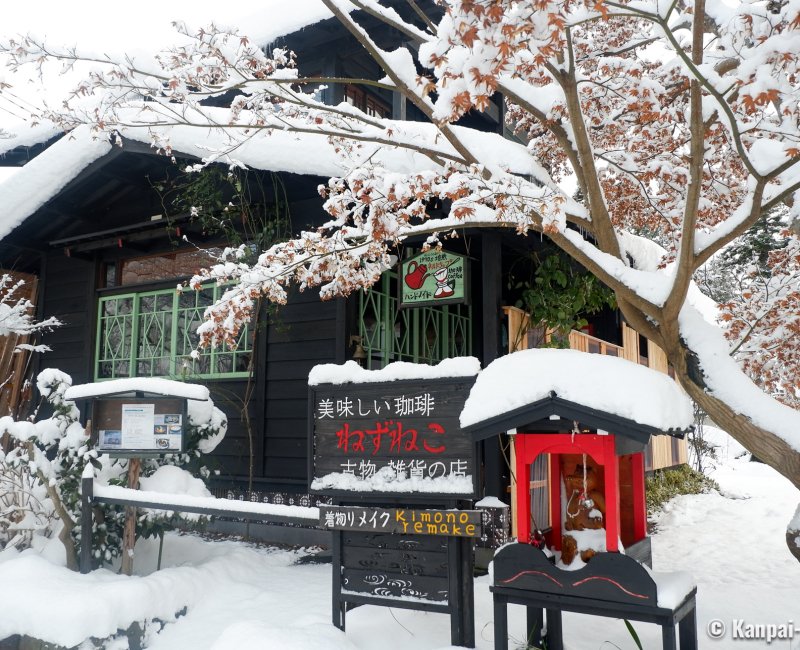
Kakunodate is mainly enjoyable from spring to autumn 🍁, when the vegetation is the more abundant and the samurai residences opened to the public. In winter, as soon as early December, abundant snowfalls give a peaceful and charming appearance to the sleeping feudal city. However, at this time of the year, very few activities are available and many lodgings are closed off season.

